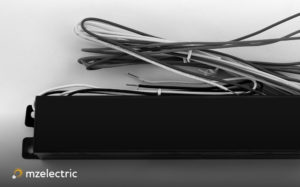What Is a Light Ballast?
Light ballasts are one of those devices that you rarely hear about but use all the time. A light ballast is a component of some light bulbs, such as fluorescent bulbs. The small, rectangular box that houses the ballast connects to the fluorescent tube and is usually tucked away within the light fixture, which is why we don’t really realize it’s even there.
 How Does a Light Ballast Work?
How Does a Light Ballast Work?
The purpose of a light ballast is to control the amount of current in a light circuit. For a fluorescent light bulb, the ballast ensures the current’s voltage doesn’t spike too high and burn out the bulb.
When you flip the switch of a fluorescent bulb, it immediately produces an arc or discharge of electricity between the two electrodes of the bulb. The light ballast regulates the electrical current that passes between the electrodes. Without a properly functioning light ballast, the fluorescent bulb would overheat in less than a second and then burn out completely.
What’s the Difference Between Residential and Commercial Light Ballasts?
While fluorescent lights are not as standard in homes in Littleton, CO, they are quite popular in many businesses and public buildings. That’s why the major difference between residential and commercial light ballasts is the frequency with which they are used.
We tend not to use fluorescent lights in our homes because the color of light they produce is more intense and feels more industrial. Also, fluorescent light bulbs cost more upfront than standard bulbs and contain mercury. The amount of mercury is negligible, but it requires the bulbs to be disposed of in a specific way, making them less convenient than other conventional bulbs.
The main reason fluorescent bulbs are standard in commercial settings is that they are more energy-efficient in the long run and have a longer lifespan. That means that even though they cost more to purchase, they will ultimately save buildings money over time. Also, many commercial spaces have lighting that is not easy to reach, so having longer-lasting fluorescent bulbs helps reduce maintenance costs.
One other factor worth noting about fluorescent light bulbs is that they produce much less heat than conventional light bulbs, about 75% less. While this feature isn’t as important for most homeowners, many businesses prefer the coolness of fluorescent bulbs due to fire safety regulations.
So, there isn’t a significant difference between a residential light ballast and a commercial one, other than possibly the size of the ballast you should use for the fluorescent tubes you have. Also, in many commercial settings, light ballasts can likely be found in every room, whereas you’d be surprised to find more than one or two in a residential setting—maybe down in your basement or your garage.
When Is It Time to Replace a Light Ballast?
The convenient thing about light ballasts is their longevity. The average ballast can work for up to 20 years before it needs replacement. Two things that could lower ballast’s lifespan are cold air (again, think basements and garages) and low-quality fluorescent light bulbs.
You’ll know there’s an issue with the light ballast when the light bulbs keep flickering or make humming noises. Also, if you’ve recently replaced the light bulbs, but they burn out again quickly, the bulbs were probably not the issue–the ballast was to blame.
Thankfully, you can purchase ballasts at any local home improvement store, and they aren’t costly. However, there are many different types of ballasts to match the many fluorescent bulbs, so you have to make sure you get the right one for your setup.
Magnetic Ballasts
Magnetic ballasts have been around for quite a while and work with fluorescent and high-intensity discharge (HID) lights. For fluorescent lighting that uses T12 linear fluorescent tubes and two-pin CFLs, you’ll want a magnetic ballast.
Electronic Ballasts
More recent lighting options will utilize electronic ballasts. These devices can fluctuate their electricity frequencies without needing to alter their input voltage. For this reason, electronic ballasts rarely produce flickering or buzzing (unless they are having issues).
If your light fixture is older and uses a magnetic ballast, you can replace it with an electronic ballast fairly easily. Still, it’s most helpful to have a professionally trained electrician do the job correctly.
Get in Touch with MZ Electric for Assistance
If you’re searching for an “electrician near me” to get help with your light ballasts or any other electrical work, give MZ Electric a call. We are the #1 electrical service provider in the Denver and Littleton, CO, area.
All of our technicians are drug tested, background checked, and professionally trained, so you don’t need to worry who you are allowing into your home. They will arrive on time and treat you home respectfully, all while assisting with your electrical needs. Give us a call or schedule service via our website today! Plus, we will also provide you with competitive rates for our services and offer discounts to seniors, teachers, and military members.
